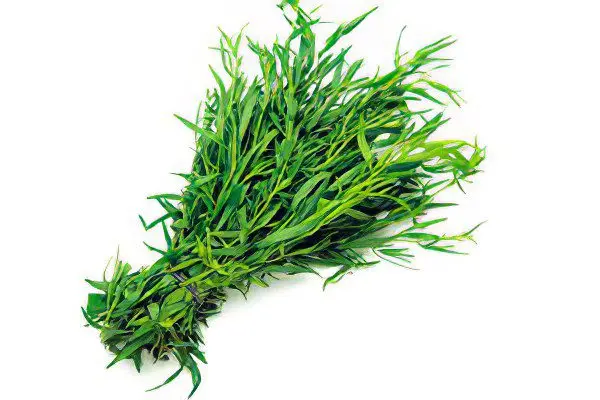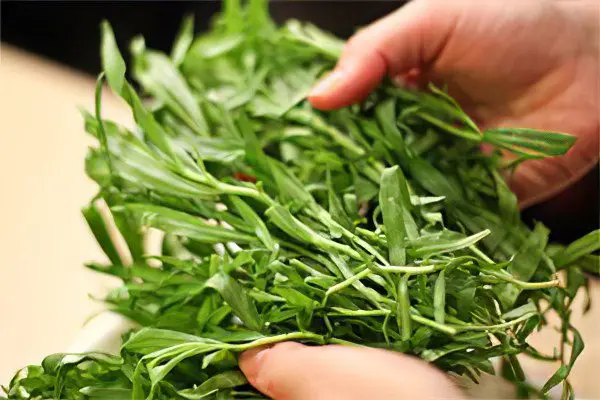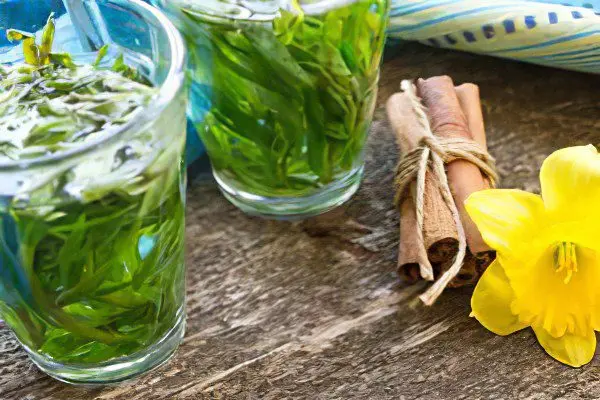Contents

This plant, which has many names (dragon grass, tarragon, dragon wormwood, Mary’s gold), is known to us as tarragon. This name takes its roots in the countries of Asia Minor, where tarragon has been widely used for many centuries. The tarragon began its triumphant journey from the steppes of Mongolia, from where it spread throughout Asia, Europe and America. Treatment of scurvy and tuberculosis, respiratory diseases, epilepsy and convulsions, strengthening of blood vessels – all these conditions were successfully treated by ancient healers with the help of tarragon. Its amazing taste is due to a rare set of useful properties and components of this spicy plant.
The aroma of tarragon resembles both the smell of mint and the sharpness of anise. Having felt it at least once, this smell cannot be forgotten. Tarragon can be found in the wild state and as a spicy crop grown in household plots. It can be prepared for future use by drying the tops of the leaves, tied into small bunches. Dried tarragon is stored in glass jars with ground hermetically sealed lids.
The benefits of tarragon
Due to its composition, tarragon is successfully used as a medicinal plant in folk medicine in many countries of the world. It enhances potency and appetite, relieves nervous tension, fights insomnia, heals the oral cavity, the state of the digestive tract.
Composition and calorie content
Calories 24,8 KKal
- Fats:
0,8 g
- Proteins:
1,5 g
- Carbohydrates:
5,0 g
- Water:
91,7 g
- Ash:
1,0 g
- Cellulose:
0,5 g
Vitamins | Quantity | % RDN |
Vitamin K | 240 mcg | 200% |
Vitamin B6 (pyridoxine) | 0,29 mg | 15% |
Vitamin C (ascorbic acid) | 10 mg | 14% |
Minerals (in 100 g): | Quantity | %RDN |
Manganese | 960,2 mcg | 48% |
Vanadium | 12,7 mcg | 32% |
potassium | 260 mg | 9% |
Full chemical composition ➤
Other important connections:
Phytosterols — 9,8 mg (17,8% of RDI)
Purine — 6 mg (5% of RDI)
Oxalic acid — 5,2 mg (1,3% of RDI)
Useful properties of tarragon
Action tarragon:
restorative,
tonic,
Antiscorbutic,
Painkiller
diuretic,
Stabilizing the work of the nervous system,
normalizing digestion,
Appetite stimulant,
regenerating,
Normalizing the menstrual cycle,
Antispasmodic,
anti-inflammatory,
Anthelmintic,
Improving potency.
In addition, tarragon is used for fortification of feed for farm animals.
The healing properties of tarragon

Traditional medicine could not ignore this valuable plant.
Tarragon successfully normalizes the human condition under the following conditions:
Low immunity;
Amenorrhea and hypermenorrhea, unstable menstrual cycle;
Headaches, migraines;
Puffiness of various origins;
scurvy, gum disease;
Insufficiency of digestive activity;
Olfactory disorders;
Decreased potency;
Arthritis and arthrosis.
Tarragon is a component not only of traditional medicine recipes, but also of homeopathic preparations for the treatment of diseases of the upper respiratory tract, pneumonia, cystitis, and urolithiasis.
Folk recipes based on tarragon:
Neurological disorders – infusion of 200 ml of boiling water and st. l. dry tarragon grass is divided into 2 doses and drink half a cup before meals;
Sciatica – painful places are smeared with cow’s oil mixed with chopped tarragon or dried grass powder;
Eczema – the affected areas of the skin are smeared with honey mixed with 1 tbsp. l. herbs;
Inflammation of the gums – an ointment of 100 g of butter and 1 tbsp is rubbed into the base of the teeth and into the gums. l. tarragon;
Toothache – chew a leaf of a plant, providing yourself with anesthesia;
Varicose veins – insist a handful of tarragon herb on half a liter of yogurt, soak gauze with this mixture and make a compress on a sore vein, wrapping it on top with compress paper or oilcloth;
Fatigue – drink half a glass of decoction of 200 ml of water and st. l. tarragon herbs;
Insomnia – make a compress from a decoction of 1 tbsp. l. herbs in a glass of boiling water, put on the forehead;
Lack of appetite – brew in a teapot for tea leaves 1 tbsp. l. tarragon herbs, 3 tbsp. l. green tea and pomegranate peel, use the infusion as a tea leaves for making a drink.
The use of tarragon
Although tarragon is used in medicine as a medicinal plant, the cuisine of many peoples of the world would lose a lot without the use of this spice. They are seasoned with salads and vegetable dishes, set off soups and cottage cheese dishes with an unusual aroma, added to marinades and sauces.
The ability of tarragon to destroy pathogenic microorganisms is used in the preservation of mushrooms, vegetables and fruits. Fish and meat dishes benefit from the neighborhood with this spice, it is part of the sauces for seasoning dishes. The flavoring of alcoholic and carbonated drinks with this original spice is very common, to which it gives a noble taste and aroma.
In diets designed to reduce excess weight, tarragon plays an important role. Its use allows you to decorate the taste of kefir or salt-free diet dishes, give them a spicy tint, and partially replace salt. Chewing fresh leaves of tarragon, you can successfully fight hunger during therapeutic fasting.
In cosmetology, tarragon juice is used as part of various skin care products for hands and face. Lightening of pigmentation, regeneration of the skin after damage, relief of inflammation, mild analgesic effect – these are the properties that are manifested in tarragon infusions.
Cosmetic recipes:
Tonic infusion – 1 tsp dried or fresh herbs pour a glass of boiling water, leave for a while, wipe the skin of the face, hands and neck.
Rejuvenating lotion – a mixture of cucumber juice and fresh tarragon juice, mixed in a ratio of 1: 1, with the addition of 2-3 drops of the essential oil of this plant, will support aging skin of the face and neck, if you wipe it 2 times a day.
Tarragon essential oil is used in the preparation of baths for relaxation and the fight against melancholy, aroma massage for the relief of neuralgia and rheumatic manifestations.
Tincture of tarragon

There are several options for creating tarragon-based alcoholic beverages.
To create a tincture with an original taste and unusual aroma, the following ingredients are needed:
Tarragon greens, fresh and coarsely chopped – 50 g;
Vodka – 0,5 l;
Honey – 1 tbsp. l.;
Sugar – 1 tsp.
The grass is mixed with sugar for 30 minutes, after a while juice will stand out from it. All ingredients are sent into a bottle, corked and infused for 3-4 days in a cool dark place. Then filter the resulting tincture, passing it through a charcoal filter. To preserve the wonderful emerald shade of the tincture, it is stored in the dark, away from sunlight.
Mint and tarragon – another tincture
In a 3-liter jar, mix the following components:
Tarragon – 100-150 g (large bunch);
Mint – 20 g;
Juice and zest of ¼ lemon;
Sugar – 2 Art. l .;
Vodka to fill the jar to the brim along with all the ingredients.
The infusion of the drink occurs within a week in the dark at room temperature. The filtered drink is cooled, used for its intended purpose. All useful properties of tarragon are preserved in tinctures from this herb in full.
How to make tarragon drink at home?
The benefits of a homemade drink far exceed the beneficial properties of its analogues purchased in the store – there is no sugar or preservatives.
Recipe number 1 – step by step preparation of tarragon drink at home:
Dissolve 1,5 tablespoons of sugar in 7 liters of water.
The saucepan with syrup is heated over low heat until the sugar is completely dissolved.
At the same time, chopped tarragon stalks are placed in the syrup, the leaves are left for now to add them later.
After boiling water, the pan is removed from the heat, cut leaves are laid in order to keep the maximum of vitamins in the drink.
After half an hour of infusion, the drink is filtered, diluted with a liter of water with gas, adding juice from 1/2 lemon.
Pour into glasses and enjoy a refreshing and delicious drink.
Recipe number 2 (preparing very quickly, no need to cook):
Wash and coarsely tear a large bunch of tarragon.
Add lime juice, lemon juice and 0,5 cups of boiled water, grind the herbal mass in a blender, or just knead everything thoroughly.
Strain the juice, squeeze it from the chopped greens.
Dilute the resulting liquid with cold water in a ratio of 1: 4, add ice cubes. Sweet lovers can add sugar syrup to taste.
This amount of the resulting drink is enough for 2 servings. The color of lemonade will not be as bright as the drink we are used to, produced under industrial conditions, but its taste and benefits undoubtedly win.
Contraindications to the use of tarragon
With all its merits, tarragon should not be consumed in large quantities and for a long time, since in excessive quantities it can cause poisoning with all the accompanying symptoms: headache, convulsions, nausea and vomiting.
Medical contraindications:
Pregnancy due to the threat of miscarriage;
Lactation;
Ulcer of the stomach and intestines;
Individual intolerance in the form of an allergic reaction;
Gastritis with high acidity.
Widely using tarragon in cooking, in the preparation of drinks and medicines, you need to observe a sense of proportion, remember about contraindications.









